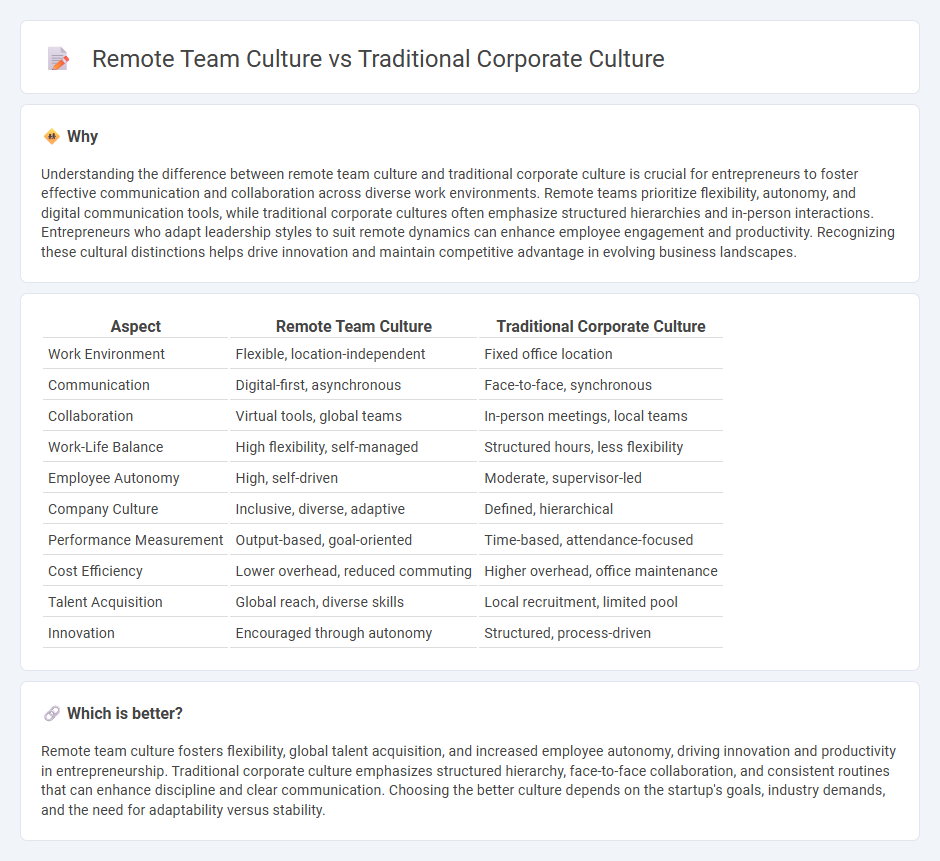
Entrepreneurship thrives on dynamic remote team cultures that emphasize flexibility, autonomy, and digital collaboration tools, contrasting sharply with traditional corporate cultures rooted in hierarchical structures and physical office environments. Remote teams often experience increased productivity and work-life balance due to asynchronous communication and location independence, while traditional settings benefit from face-to-face interactions and established workflows. Explore how these cultural models impact innovation, employee engagement, and business scalability in the entrepreneurial landscape.
Why it is important
Understanding the difference between remote team culture and traditional corporate culture is crucial for entrepreneurs to foster effective communication and collaboration across diverse work environments. Remote teams prioritize flexibility, autonomy, and digital communication tools, while traditional corporate cultures often emphasize structured hierarchies and in-person interactions. Entrepreneurs who adapt leadership styles to suit remote dynamics can enhance employee engagement and productivity. Recognizing these cultural distinctions helps drive innovation and maintain competitive advantage in evolving business landscapes.
Comparison Table
| Aspect | Remote Team Culture | Traditional Corporate Culture |
|---|---|---|
| Work Environment | Flexible, location-independent | Fixed office location |
| Communication | Digital-first, asynchronous | Face-to-face, synchronous |
| Collaboration | Virtual tools, global teams | In-person meetings, local teams |
| Work-Life Balance | High flexibility, self-managed | Structured hours, less flexibility |
| Employee Autonomy | High, self-driven | Moderate, supervisor-led |
| Company Culture | Inclusive, diverse, adaptive | Defined, hierarchical |
| Performance Measurement | Output-based, goal-oriented | Time-based, attendance-focused |
| Cost Efficiency | Lower overhead, reduced commuting | Higher overhead, office maintenance |
| Talent Acquisition | Global reach, diverse skills | Local recruitment, limited pool |
| Innovation | Encouraged through autonomy | Structured, process-driven |
Which is better?
Remote team culture fosters flexibility, global talent acquisition, and increased employee autonomy, driving innovation and productivity in entrepreneurship. Traditional corporate culture emphasizes structured hierarchy, face-to-face collaboration, and consistent routines that can enhance discipline and clear communication. Choosing the better culture depends on the startup's goals, industry demands, and the need for adaptability versus stability.
Connection
Remote team culture and traditional corporate culture intersect through shared values such as collaboration, accountability, and innovation, which form the foundation for organizational success. Effective communication technologies and leadership styles adapt these values to support team cohesion across dispersed work environments. Aligning these cultures enhances employee engagement, productivity, and the overall entrepreneurial mindset within a company.
Key Terms
Hierarchical Structure vs. Distributed Autonomy
Traditional corporate culture emphasizes a hierarchical structure with clear chains of command and centralized decision-making, fostering stability and defined roles. Remote team culture promotes distributed autonomy, empowering individuals with flexibility, trust, and decentralized decisions to enhance collaboration across time zones. Explore deeper insights on balancing hierarchical control and autonomous work in diverse corporate environments.
Office Presence vs. Digital Collaboration
Traditional corporate culture emphasizes office presence, where in-person interactions and physical workspace foster team cohesion and immediate communication. Remote team culture prioritizes digital collaboration through virtual meetings, cloud-based tools, and asynchronous workflows to maintain productivity and connectivity regardless of location. Explore how these distinct cultures impact employee engagement and organizational success in modern business environments.
Fixed Hours vs. Flexible Scheduling
Traditional corporate culture often emphasizes fixed hours, requiring employees to adhere to strict 9-to-5 schedules that promote consistency and direct supervision. Remote team culture prioritizes flexible scheduling, allowing team members to work during their most productive periods and accommodate varying time zones, enhancing work-life balance and autonomy. Discover how shifting from fixed hours to flexible schedules can boost productivity and employee satisfaction in your organization.
Source and External Links
4 different types of company culture explained - Breathe HR - Traditional corporate culture is often described as a hierarchy culture characterized by structure, control, many layers of management, strict rules, and a focus on "doing things right" to keep the business running smoothly, exemplified by companies like McDonald's.
4 Common Types of Corporate Culture | Indeed.com - Hierarchy culture in traditional corporations features clear lines between management and employees, risk-averse environments, rigid structures with defined work hours and dress codes, where decisions are centrally made and change is slow, common in banking and fast-food industries.
12 Types of Organizational Cultures + Examples - SurveyLegend - Traditional organizations often have hierarchy cultures where power and decision-making are concentrated at the top, employees know their roles but may feel undervalued, resulting in efficiency but limited creativity and slower innovation, with Walmart and Barclays as examples.
 dowidth.com
dowidth.com